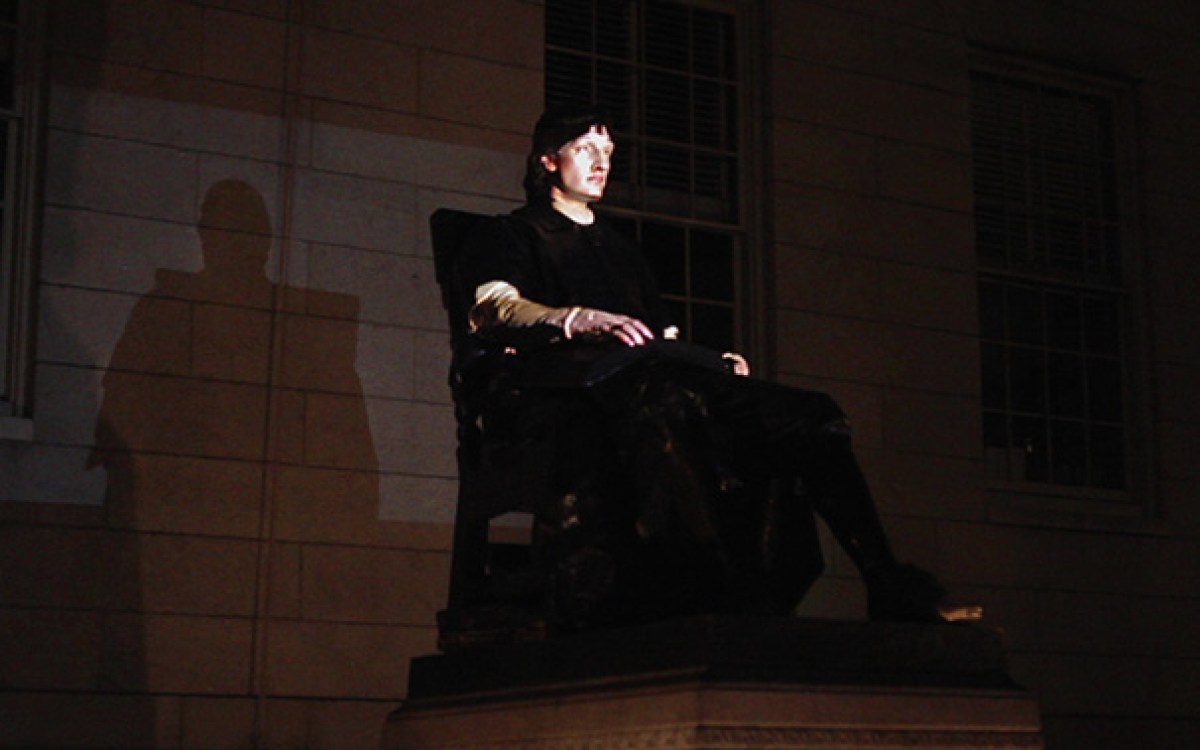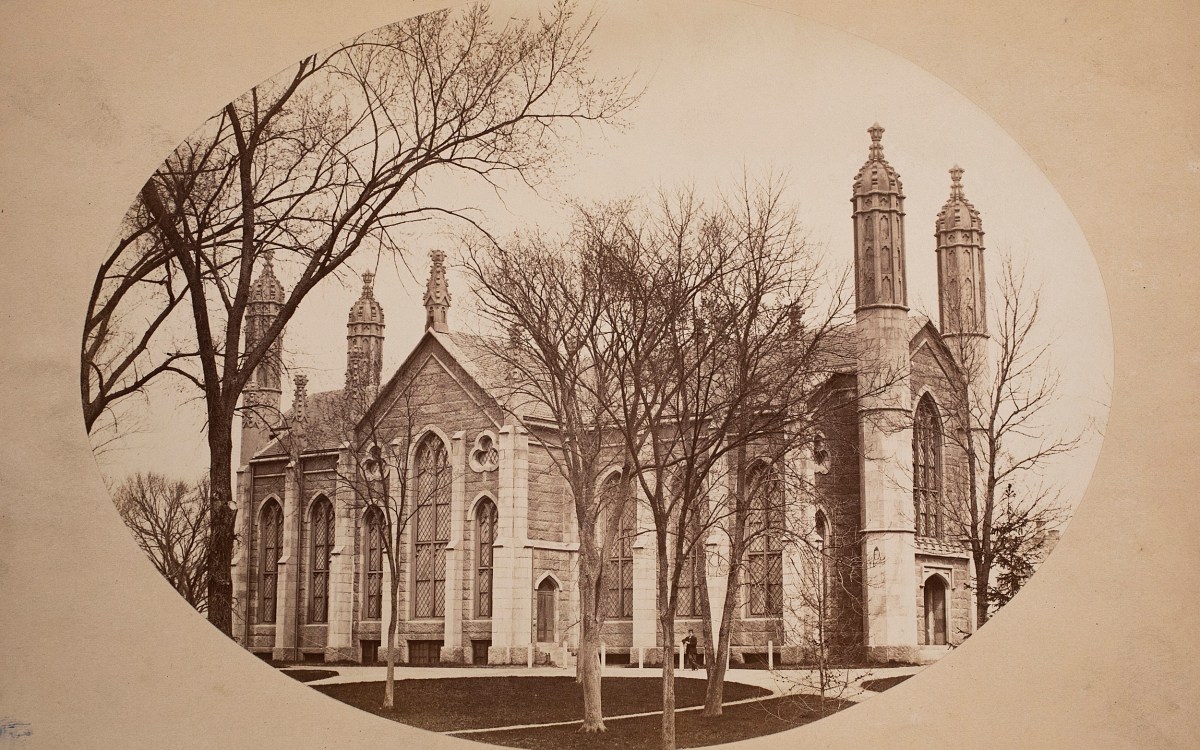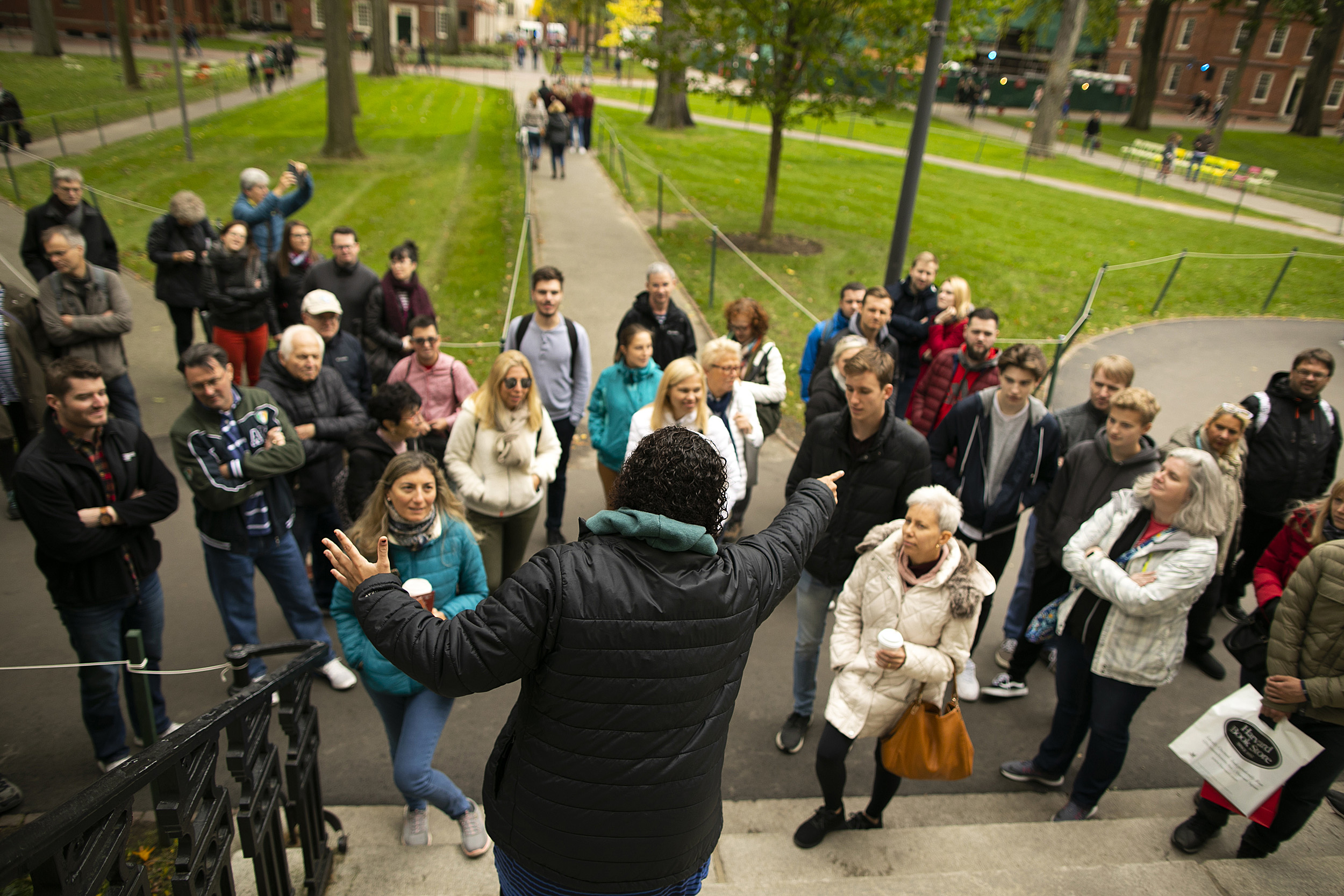
Rachel Gilchrist leads a tour through Harvard Yard.
Photos by Stephanie Mitchell/Harvard Staff Photographer
Three lies and lots of truths on campus
Tagging along on a student-led historical tour
On a recent crisp, sunny morning, Rachel “Rae” Gilchrist waited at the Richard A. and Susan F. Smith Campus Center for the first of two tours she would lead that day. For Gilchrist, a fast talker with the gift of gab, working as a campus tour guide is the perfect job.
“I like to talk to people,” says Gilchrist ’20. “I like to make them laugh and entertain them. I talk. They listen. It’s perfect.”
Gilchrist is among 20 students who work at the Harvard University Visitor Center, answering questions from guests and leading the University’s official historical tours.
So far this year, the center has served 34,000 visitors. The tours’ two biggest selling points? They’re free, and they’re led by Harvard students.
Gilchrist, a native of Bridgewater, Va., and the first in her family to attend college, earns extra money by working 30 hours a week as a guide on Tuesdays and Thursdays and at a computer lab on Sundays.
The tour job, though, is by far her favorite, she says, not only because it pays $16 an hour but because she gets to tell people about her School.
“Even if you go to Harvard for four years, you don’t necessarily know all the historical information about the University,” she says. “I don’t think I would have known the things I know if I hadn’t gotten this job.”
The Gazette followed Gilchrist on a tour, and here are some of the highlights.

Wadsworth House
Gilchrist greets a group of 35 who hail from England, Argentina, Israel, and the U.S., among other places.
“Welcome to Harvard,” she says at the first stop: Wadsworth House, a 1726 Colonial that sits on Massachusetts Avenue, amid the buzz of students, buses, cars, and passersby.
Built initially for the president of the College, Gilchrist tells the group, the yellow clapboard House served as headquarters for George Washington when he led the Continental Army in 1775. Many people, including a number of students, don’t know that Washington slept there. The mention of Washington’s name elicits oohs and aahs.
Wadsworth, the second-oldest building in Harvard Yard, is considered the University’s “front door” and is now where the University Marshall receives foreign dignitaries and distinguished visitors.
Gilchrist calls the group’s attention to a plaque on the side of the structure that commemorates Titus, Venus, Bilhah, and Juba, slaves who lived and worked in the house during the 18th century and were owned by Harvard presidents Benjamin Wadsworth and Edward Holyoke. The plaque was dedicated during Drew Faust’s tenure as University president in a special ceremony attended by U.S. Rep. John Lewis, a legendary leader of the Civil Rights Movement.
“Before the plaque was added in 2016, the contributions of Titus, Venus, Bilhah, and Juba to Harvard for a long time had been erased,” Gilchrist says. “Now we can remember them. Their hard work made this University what it is.”
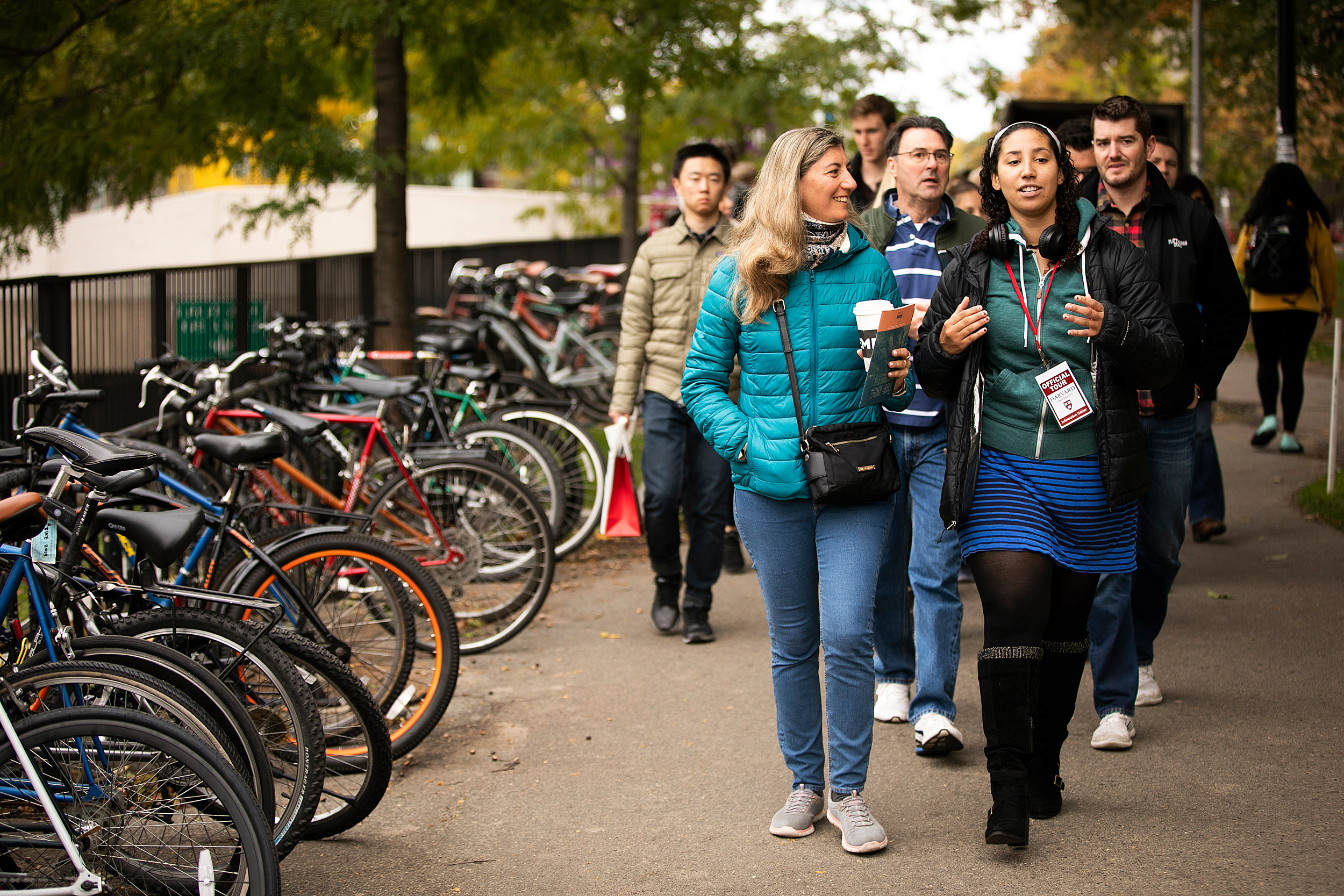
Before moving to the next stop, Gilchrist offers some Harvard trivia, including when it was founded (1636), by whom (Massachusetts Bay Colony), and for whom it was named (John Harvard, the School’s first benefactor).
“In 1638, after John Harvard’s death, he bequeathed half his estate and all of his library and the institution was renamed after him, and that started a long-lasting trend of buildings being renamed after donors,” Gilchrist says with a grin.
Winking, she asks her group to pay attention to these pieces of information because “there will be a quiz at the end …”

Harvard Hall
The group moves to the heart of Harvard Yard. Gilchrist points to two old red-brick buildings and shares that those were the first-year dorms of Malia Obama ’21 and Matt Damon, drawing smiles and nods. She then notes where Harvard Indian College once stood. Founded in the mid-17th century, its mission was to educate Native American youth.
In front of Mass Hall, the oldest building in the Yard, Gilchrist recounts the history of the red-brick early Georgian structure, built between 1718 and 1720. Washington occupied the building with 640 soldiers in the late 1700s. It now serves as the offices for Harvard’s president, and the top floors are dorms where 12 lucky first-years live.
Washington occupied the building with 640 soldiers in the late 1700s.
A few feet away sits Harvard Hall, Gilchrist’s favorite stop because of its rich history. First built in 1644, it rotted to the ground about a quarter of a century later. The second building was put up in 1677, but it was destined to be only be the second of three.
It contained most of the College’s books, including those donated by Harvard, besides a collection of scientific instruments. “Until a cold and stormy night on Jan. 24, 1764,” says Gilchrist. “Students couldn’t check out the books; they had to be read in the library, but a student by the name of Ephraim Briggs had taken out a book, ‘The Christian Warfare Against the Devil, World and Flesh’ …
“And thank goodness he did,” she says, pausing for effect, “because the building burned down that night. He returned the book, which was the only surviving book of John Harvard’s collection. The president of Harvard thanked Briggs and then expelled him … No good deed goes unpunished.”
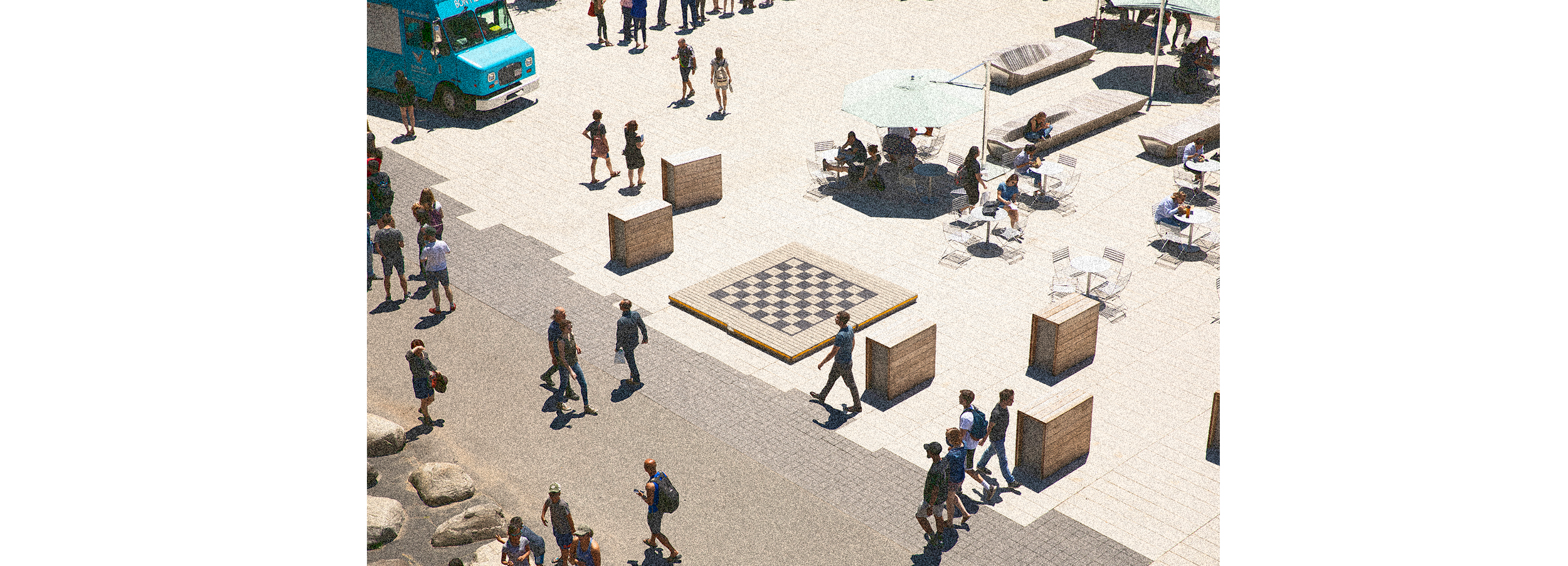
Science Center Plaza
A senior concentrating in astrophysics, Gilchrist has a soft spot for anything related to science. At Science Center Plaza, a major crossroad between Harvard Yard and the Science Center, she revels in describing the telescopes on the roof and the center’s significance for students.
The Science Center is the hub of first-year academics, Gilchrist says. “Almost every single freshman takes at least one class in this building. There are five large lecture halls where a lot of introductory classes are taught, and they don’t necessarily have to do with science.”
Over the course of the tour it becomes apparent why having students lead the tours is a major draw. Interest is high in what classes and campus life are like, and the tours give people a chance to chat with students about it, said Robin Parker, associate director of the visitor center.
“Who better to represent Harvard University than a Harvard student?” asked Parker.
When people ask Gilchrist how she feels about being a Harvard student, she is not shy about it. “I love it here,” she says. “But I also feel a strong obligation to make my Harvard degree count by using it to help others.”
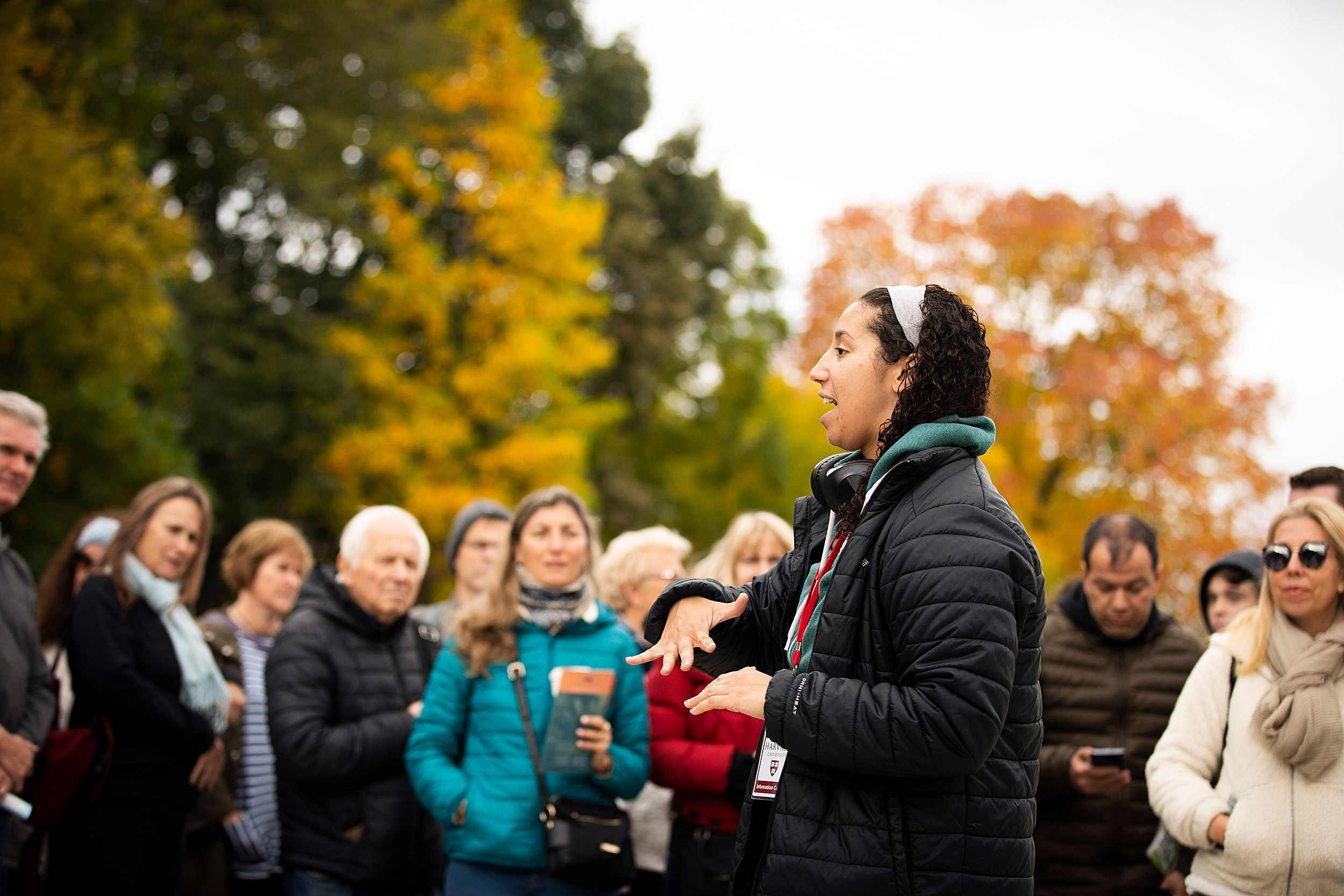
People react with surprise when Gilchrist tells them the price tag of a Harvard education (about $70,000 a year) and also when she explains how financial aid works at the University.
“It’s entirely need-based,” she says. “If your family makes less than $65,000 a year, Harvard will offer you a very generous package with an almost 99 percent discount, and if your family makes more than $65,000, it can still offer you a very considerable financial aid, but first you have to apply and be accepted.”
If anyone asks Gilchrist any detailed admission questions, she reminds them she is doing a historical and not an admissions tour, which are handled by the Office of Admissions and include an information session. When doing private tours for high school students, Gilchrist tends to offer a little more information about the process, but she refrains from going deep.
Gilchrist highlights the social clubs — the College recognizes about 400 of them — which help students put some balance in their busy lives. “I myself am in the Harvard University Band,” she says. “And we specialize in shenanigans, and occasionally play instruments.”
To graduate, students must take 32 courses, one-third in their field of concentration, another third in general education, and the final third in anything they’d like to explore. “That’s the beauty of a liberal arts education,” she says.

Memorial Hall and Church
On the outside, Memorial Hall resembles a church. Built between 1870 and 1878 to honor 136 Harvard graduates who fought for the Union and died in the Civil War, the building is an example of high Victorian Gothic architecture and is a National Historic Landmark.
As Gilchrist’s group enters the building, heads tilt back as the visitors look up to admire the high, vaulted ceiling, the stained-glass windows, and the black-walnut paneling inside. The stop is one of the most popular for selfies.
Memorial Hall also houses Sanders Theatre, which is used for concerts, classes, and special ceremonies, and Annenberg Hall, the first-year dining hall that can seat more than 1,000 students at a time and bears a resemblance to the Great Hall in Hogwarts Castle.
“Can we take a peek at Annenberg?” is a common request.
To the sightseers’ chagrin, neither the theater nor the dining hall is open to the public. “This is the moment when I have to break hearts,” says Gilchrist.
“Annenberg Hall is exclusive for first-years only,” says Gilchrist. “If it makes you feel any better, I can’t go inside there myself. They are very strict about it.”
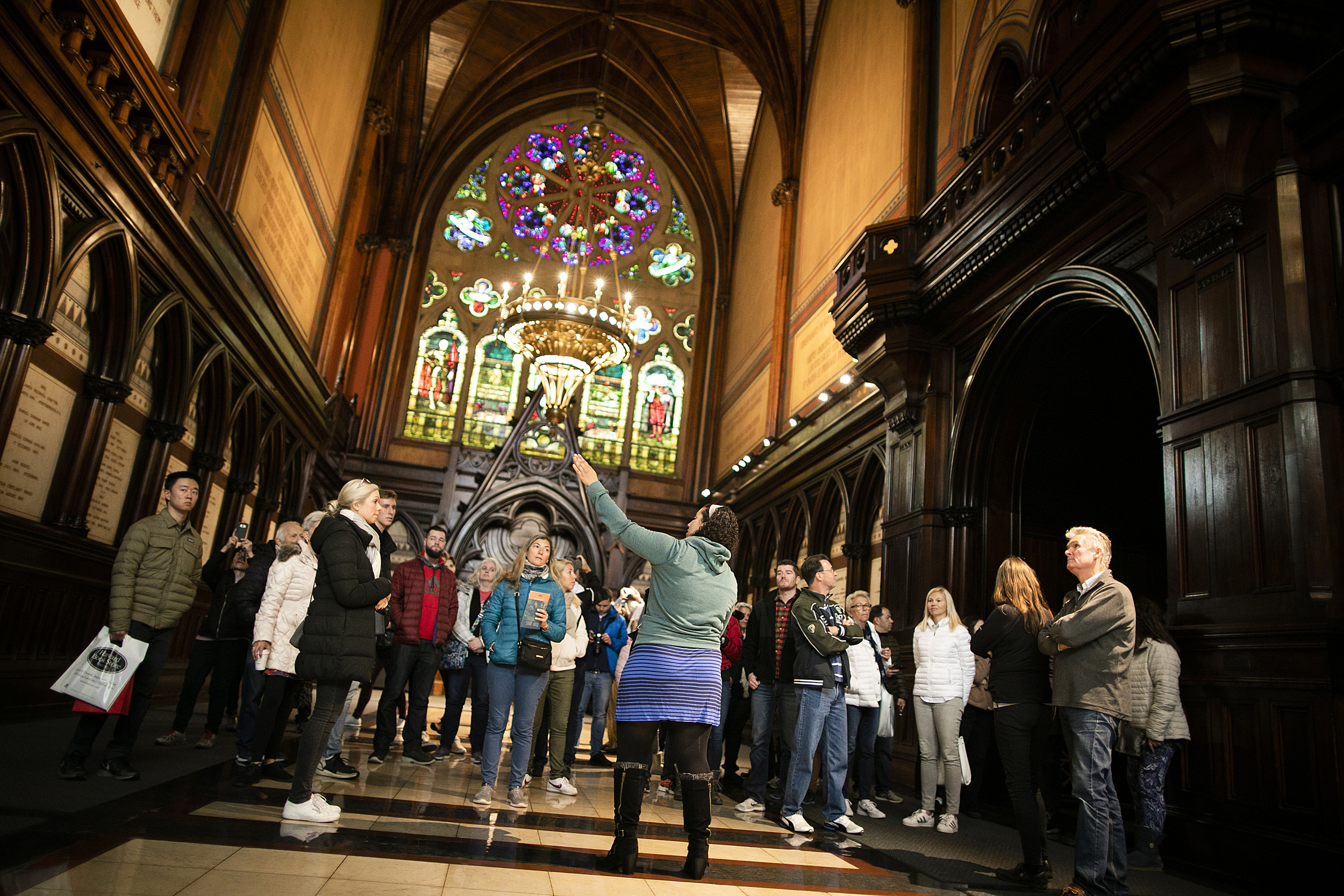
On a recent tour of high school students from India, Shobhna Aggarwal, a ninth-grader at Apeejay School, Punjab, was intrigued by Annenberg.
“I’d love to see the dining hall,” Aggarwal says. “I’m a huge ‘Harry Potter’ fan. It must be amazing.”
After Memorial Hall, Gilchrist leads the group to the center of the Yard. As they stand on the steps of Memorial Church, she points to the green expanse between the church and Widener Library, where Commencement Exercises take place every May.
“Fun fact,” she says. “Every building in Harvard, including Memorial Church, has classrooms.”
Nearly 7,000 students graduate every year, and the Yard is filled with about 20,000 folding chairs for students, their relatives, and guests. The festivities feature centuries-old traditions and notable speakers. In recent years graduates have heard from German Chancellor Angela Merkel, Harry Potter creator J.K. Rowling, and two of Harvard’s most famous dropouts, Microsoft founder Bill Gates and Facebook founder Mark Zuckerberg. Both Gates and Zuckerberg received honorary degrees when they came to speak.
The weather can be awful, says Gilchrist, “but it’s a once-in-a-lifetime event as a Harvard student. They give you two guest tickets as a graduate. My family right now is fighting to the death.”

Widener Library
Directly across from Memorial Church sits the Harry Elkins Widener Memorial Library, an imposing building whose entrance is graced with 12 Roman pillars and stands atop a 27-step granite staircase. Widener has 10 floors filled with 3.5 million books and is the largest university library in the world.
Gilchrist tells the group the library’s tragic origin story. Widener, a Philadelphia businessman and book collector who graduated from Harvard in 1907, died on the Titanic in 1912.
“Harry is about to board a lifeboat with his father and mother, but he realizes he had forgotten the second edition of Francis Bacon’s ‘Essais’ in his room in the Titanic and he goes back, followed by his dad,” says Gilchrist. “Neither of them is ever heard from again.”
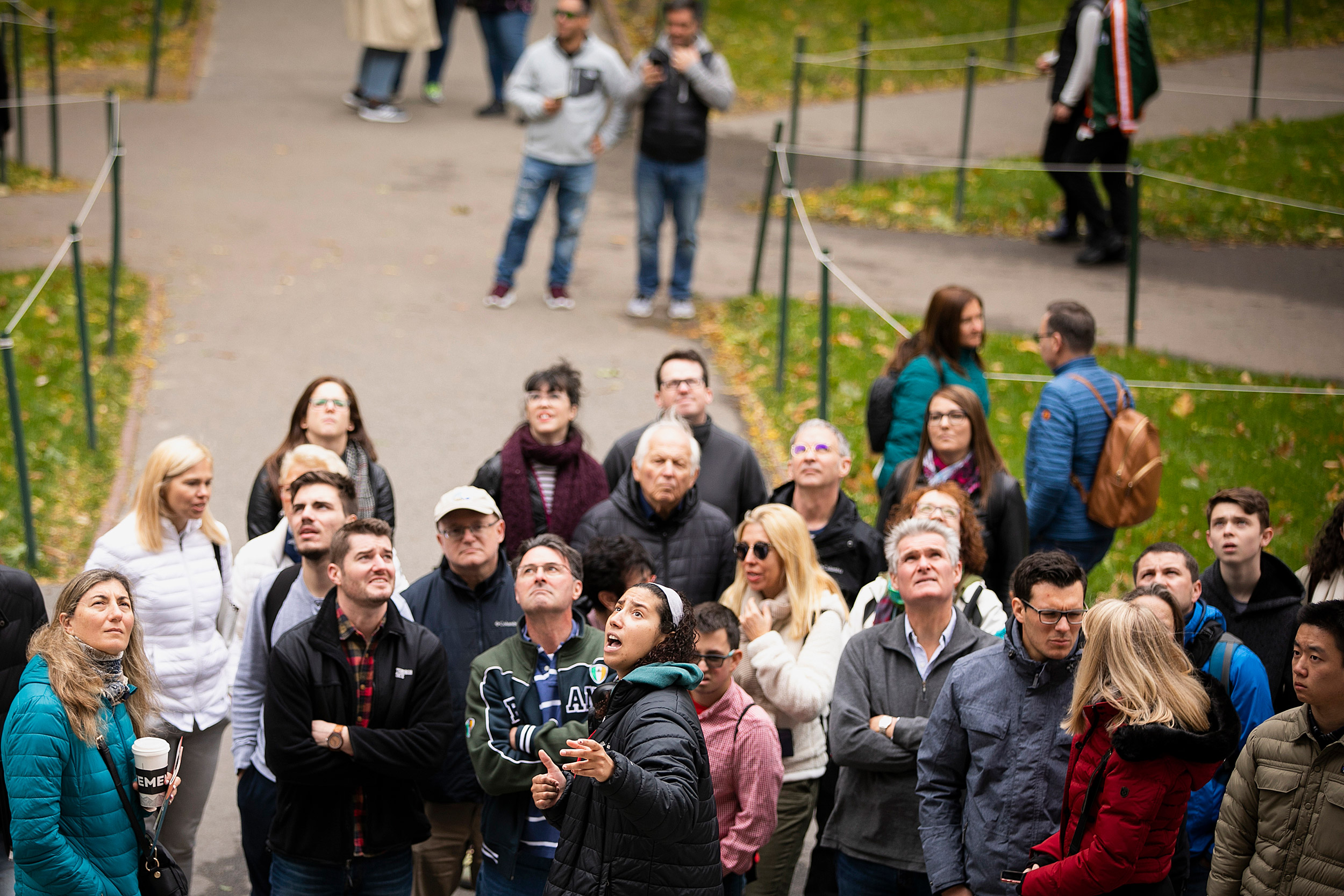
Widener’s mother, Eleanor Elkins Widener, donated her son’s rare-book collection, including a Gutenberg Bible and a Shakespeare Folio, and $2 million to the College to build a library in honor of her son’s memory. But she set two conditions: that no stone, brick, or mortar of the outside of the building ever be changed and that a replica of Widener’s home study be situated in the center of the library.
“In the center of the room, there’s his Gutenberg Bible,” Gilchrist said. “And every day, somebody turns a page of the Gutenberg Bible, and every day, somebody places fresh flowers in a vase on his desk.”
Some say there was a third condition: that every incoming student pass a swim test (Widener didn’t know how to swim). But that’s a myth.

John Harvard Statue
As the tour wraps up, Gilchrist leads the group to the last stop: the iconic namesake statue.
Located in front of University Hall, the life-size bronze can’t be missed. It is often surrounded by tourists and visitors who line up to take pictures with it. Along with the Statue of Liberty and Lincoln Memorial, it’s one of the most-photographed statues in the country, says Gilchrist.
Following a superstition of unknown origin, most visitors touch the figure’s feet hoping it will bring good luck. The constant rubbing, which has prevented a patina from developing, has buffed the left foot shiny.
Attired as a 17th-century clergyman, the young man sits on a chair, a book balanced on his right knee, with three lines inscribed: “John Harvard. Founder. 1638.”
“This statue is also known as the ‘statue of three lies,’” says Gilchrist. “Can anyone tell me what those lies are?”
After a brief silence, Gilchrist reminds the group the University was founded in 1636, not 1638, and by the Massachusetts Bay Colony, not John Harvard. And the third lie?
“That’s not John Harvard,” Gilchrist says, as people erupt in laughter. “That’s some guy, a particularly regal-looking guy.”
All portraits of Harvard were lost in the fire of 1764. Unveiled in 1884, the model for the statue was Sherman Hoar, a Harvard student and descendant of Harvard’s fourth president, Leonard Hoar.
The tour left Maria Laura Santarelli, a tourist from Argentina, with a desire to come back. After taking a picture next to the statue, she expressed a feeling common among visitors: “I wish my son could come here.”
When Gilchrist announces the tour’s end, people clap enthusiastically. While they linger to take pictures, Gilchrist walks back to the Smith Center. She has to get ready for her next tour.




